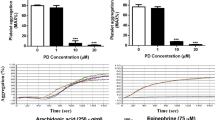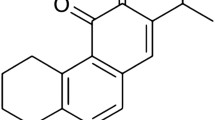Abstract
Thrombocytopenia is a major hematological concern in oxidative stress-associated pathologies and chronic clinical disorders, where premature platelet destruction severely affects the normal functioning of thrombosis and hemostasis. In addition, frequent exposure of platelets to chemical entities and therapeutic drugs immensely contributes in the development of thrombocytopenia leading to huge platelet loss, which might be fatal sometimes. Till date, there are only few platelet protective molecules known to combat thrombocytopenia. Hence, small molecule therapeutics are extremely in need to relieve the burden on limited treatment strategies of thrombocytopenia. In this study, we have synthesized a series of novel 3,4,5 trisubstituted isoxazole derivatives, among which compound 4a [4-methoxy-N’-(5-methyl-3-phenylisoxazole-4-carbonyl) benzenesulfonohydrazide] was found to significantly ameliorate the oxidative stress-induced platelet apoptosis by restoring various apoptotic markers such as ROS content, cytosolic Ca2+ levels, eIF2-α phosphorylation, mitochondrial membrane depolarization, cytochrome c release, caspase activation, PS externalization, and cytotoxicity markers. Additionally, compound 4a dose dependently inhibits collagen-induced platelet aggregation. Hence, compound 4a can be considered as a prospective molecule in the treatment regime of platelet activation and apoptosis and other clinical conditions of thrombocytopenia. Further studies might ensure the use of compound 4a as a supplementary therapeutic agent to treat, thrombosis and CVD-associated complications. Over all, the study reveals a platelet protective efficacy of novel isoxazole derivative 4a with a potential to combat oxidative stress-induced platelet apoptosis.









Similar content being viewed by others
References
Gyulkhandanyan AV, Mutlu A, Freedman J, Leytin V (2012) Markers of platelet apoptosis: methodology and applications. J Thromb Thrombolysis 33:397–411
Grozovsky R, Hoffmeister KM, Falet H (2010) Novel clearance mechanisms of platelets. Curr Opin Hematol 17:585–589
Sobotková A, Másová-Chrastinová L, Suttnar J, Stikarová J, Májek P, Reicheltová Z, Kotlín R, Weisel JW, Malý M, Dyr JE (2009) Antioxidants change platelet responses to various stimulating events. Free Radic Biol Med 47:1707–1714. doi:10.1016/j.freeradbiomed.2009.09.015
Chu SG, Becker RC, Berger PB, Bhatt DL, Eikelboom JW, Konkle B, Mohler ER, Reilly MP, Berger JS (2010) Mean platelet volume as a predictor of cardiovascular risk: a systematic review and meta-analysis. J Thromb Haemost 8:148–156. doi:10.1111/j.1538-7836.2009.03584.x
Dindar S, Cinemre H, Sengul E, Annakkaya AN (2013) Mean platelet volume is associated with glycaemic control and retinopathy in patients with Type 2 diabetes mellitus. West Indian Med J 62:519–523. doi:10.7727/wimj.2012.284
Gowert NS, Donner L, Chatterjee M, Eisele YS, Towhid ST, Münzer P, Walker B, Ogorek I, Borst O, Grandoch M, Schaller M, Fischer JW, Gawaz M, Weggen S, Lang F, Jucker M, Elvers M (2014) Blood platelets in the progression of Alzheimer’s disease. PLoS ONE 9:e90523. doi:10.1371/journal.pone.0090523
Tang WH, Stitham J, Jin Y, Liu R, Lee SH, Du J, Atteya G, Gleim S, Spollett G, Martin K, Hwa J (2014) Aldose reductase mediated phosphorylation of p53 leads to mitochondrial dysfunction, and damage in diabetic platelets. Circulation 129:1598–1609. doi:10.1161/CIRCULATIONAHA.113.005224
Griendling KK, Fitz Gerald GA (2003) Oxidative stress and cardiovascular injury: part I: basic mechanisms and in vivo monitoring of ROS. Circulation 108:1912–1916
Assinger A (2014) Platelets and Infection—an emerging role of platelets in viral infection. Front Immunol 5:1–12. doi:10.3389/fimmu.2014.00649
Seghatchian J, Krailadsiri P (2001) Platelet storage lesion and apoptosis: are they related? Transfus Apheresis Sci 24:103–105. doi:10.1016/S0955-3886(00)00134-X
Guclu E, Durmaz Y, Karabay O (2013) Effect of severe sepsis on platelet count and their indices. Afr Health Sci 13(2):333–338. doi:10.4314/ahs.v13i2.19
Wang T, Liu Z, Wang Z, Duan M, Li G, Wang S, Li W, Zhu Z, Wei Y, Christiani DC, Li A, Zhu X (2014) Thrombocytopenia is associated with acute respiratory distress syndrome mortality: an international study. PLoS ONE 9(4):e94124. doi:10.1371/journal.pone.0094124
Thushara RM, Hemshekhar M, Kemparaju K, Rangappa KS, Devaraja S, Girish KS (2014) Therapeutic drug-induced platelet apoptosis: an overlooked issue in pharmacotoxicology. Arch Toxicol 88:185–198. doi:10.1007/s00204-013-1185-3
Zhang W, Zhao L, Liu J, Du J, Wang Z, Ruan C, Dai K (2012) Cisplatin induces platelet apoptosis through the ERK signaling pathway. Thromb Res 130:81–91. doi:10.1016/j.thromres.2012.02.013
Nayak MK, Dash A, Singh N, Dash D (2014) Aspirin delimits platelet life span by proteasomal inhibition. PLoS ONE 9:e105049. doi:10.1371/journal.pone.0105049
Inai Y, Yabuki M, Kanno T, Akiyama J, Yasuda T, Utsumi K (1997) Valinomycin induces apoptosis of ascites hepatoma cells (AH-130) in relation to mitochondrial membrane potential. Cell Struct Funct 22:555–563
Paul M, Hemshekhar M, Thushara RM, Sundaram MS, NaveenKumar SK, Naveen S, Devaraja S, Somyajit KR, West Basappa, Nayaka SC, Zakai UI, Nagaraju G, Rangappa KS, Kemparaju K, Girish KS (2015) Methotrexate promotes platelet apoptosis via jnk-mediated mitochondrial damage: alleviation by N-acetylcysteine and N-acetylcysteine amide. PLoS ONE 10:e0127558. doi:10.1371/journal.pone.0127558
Thushara RM, Hemshekhar M, Basappa Kemparaju K, Rangappa KS, Girish KS (2015) Biologicals, platelet apoptosis and human diseases: an outlook. Crit Rev Oncol Hematol 93:149–158. doi:10.1016/j.critrevonc.2014.11.002
Franco AT, Corken A, Ware J (2015) Platelets at the interface of thrombosis, inflammation, and cancer. Blood 126:582–588. doi:10.1182/blood-2014-08-531582
Rakesh KS, Jagadish S, Vinayaka AC, Hemshaker M, Paul M, Thushara RM, Sundaram MS, Swaroop TR, Mohan CD, Basappa Sadashiva MP, Kemparaju K, Girish KS, Rangappa KS (2014) A new ibuprofen derivative inhibits platelet aggregation and ROS mediated platelet apoptosis. PLoS ONE 9:e107182. doi:10.1371/journal.pone.0107182
Nantermet PG, Barrow JC, Lundell GF, Pellicore JM, Rittle KE, Young M, Freidinger RM, Connolly TM, Condra C, Karczewski J, Bednar RA, Gaul SL, Gould RJ, Prendergast K, Selnick HG (2002) Discovery of a nonpeptidic small molecule antagonist of the human platelet thrombin receptor (PAR-1). Bioorg Med Chem Lett 12:319–323
Lee YS, Park SM, Kim BH (2009) Synthesis of 5-isoxazol-5-yl-2′-deoxyuridines exhibiting antiviral activity against HSV and several RNA viruses. Bioorg Med Chem Lett 19:1126–1128. doi:10.1016/j.bmcl.2008.12.103
Simoni D, Rondanin R, Baruchello R, Rizzi M, Grisolia G, Eleopra M, Grimaudo S, Di Cristina A, Pipitone MR, Bongiorno MR, Aricò M, Invidiata FP, Tolomeo M (2008) Novel terphenyls and 3, 5-diaryl isoxazole derivatives endowed with growth supporting and antiapoptotic properties. J Med Chem 51:4796–4803. doi:10.1021/jm800388m
Lilienkampf A, Pieroni M, Wan B, Wang Y, Franzblau SG, Kozikowski AP (2010) Rational design of 5-phenyl-3-isoxazolecarboxylic acid ethyl esters as growth inhibitors of Mycobacterium tuberculosis. A potent and selective series for further drug development. J Med Chem 53:678–688. doi:10.1021/jm901273n
Simoni D, Rondanin R, Baruchello R, Rizzi M, Grisolia G, Eleopra M, Grimaudo S, Di Cristina A, Pipitone MR, Bongiorno MR, Aricò M, Invidiata FP, Tolomeo M (2008) Novel terphenyls and 3,5-diaryl isoxazole derivatives endowed with growth supporting and anti-apoptotic properties. J Med Chem 51:4796–4803. doi:10.1021/jm800388m
Reed PW, Lardy HA (1972) A23187: a divalent cation ionophore. J Biol Chem 247:6970–6977
Yamaguchi T, Takamura H, Matoba T, Terao J (1998) HPLC method for evaluation of the free radical-scavenging activity of foods by using1, 1,-diphenyl- 2- picrylhydrazyl. Biosci Biotechnol Biochem 62:1201–1204
Hsieh CL, Yan GC (2000) Antioxidant actions of du-zhong (Eucommia ulmoides Oliv.) toward oxidative damage in biomolecules. Life Sci 66:1387–1400
Thushara RM, Hemshekhar M, Paul M, Shanmuga Sundaram M, Shankar RL, Kemparaju K, Girish KS (2014) Crocin prevents sesamol-induced oxidative stress and apoptosis in human platelets. J Thromb Thrombolysis 38:321–330. doi:10.1007/s11239-014-1056-7
Lopez JJ, Salido GM, Go’mez-Artet E, Rosado JA, Pariente JA (2007) Thrombin induces apoptotic events through the generation of reactive oxygen species in human platelets. J Thromb Haemost 5:1283–1291. doi:10.1111/j.1538-7836.2007.02505
Girish KS, Paul M, Thushara RM, Hemshekhar M, Shanmuga Sundaram M, Rangappa KS, Kemparaju K (2013) Melatonin elevates apoptosis in human platelets via ROS mediated mitochondrial damage. Biochem Biophys Res Commun 438:198–204. doi:10.1016/j.bbrc.2013.07.053
Salvioli S, Ardizzoni A, Franceschi C, Cossarizza A (1997) JC-1, but not DiOC6(3) or Rhodamine 123, is a reliable fluorescent probe to assess delta psi changes in intact cells: implications for studies on mitochondrial functionality during apoptosis. FEBS Lett 411:77–82. doi:10.1016/S0014-5793(97)00669-8
Ferlini C, Scambia G (2007) Assay for apoptosis using the mitochondrial probes, Rhodamine 123 and 10-N-nonyl acridine orange. Nat Protoc 2:3111–3114. doi:10.1038/nprot.2007.397
Petronilli V, Miotto G, Canton M, Brini M, Colonna R, Bernardi P, Di Lisa F (1999) Transient and long-lasting openings of the mitochondrial permeability transition pore can be monitored directly in intact cells by changes in mitochondrial calcein fluorescence. Biophys J 76:725–734. doi:10.1016/S0006-3495(99)77239-5
Amor NB, Pariente JA, Salido GM, Rosado JA, Bartegi A (2006) Thrombin induced caspases 3 and 9 translocation to the cytoskeleton is independent of changes in cytosolic calcium in human platelets. Blood Cells Mol Dis 36:392–401. doi:10.1016/j.bcmd.2006.03.002
NaveenKumar SK, Thushara RM, Sundaram MS, Hemshekhar M, Paul M, Thirunavukkarasu C, Basappa Nagaraju G, Raghavan SC, Girish KS, Kemparaju K, Rangappa KS (2015) Unconjugated bilirubin exerts pro-apoptotic effect on platelets via p38-MAPK activation. Sci Rep 5:15045. doi:10.1038/srep15045
Owen JB, Butterfield DA (2010) Measurement of oxidized/reduced glutathione ratio. Methods Mol Biol 648:269–277. doi:10.1007/978-1-60761-756-3_18
Sundaram MS, Hemshekhar M, Thushara RM, Santhosh MS, Kumar SK, Paul M, Devaraja S, Kemparaju K, Rangappa KS, Girish KS (2014) Tamarind seed extract mitigates the liver oxidative stress in arthritic rats. Food Funct 5:587–597. doi:10.1039/c3fo60381d
Kumar MS, Girish KS, Vishwanath BS, Kemparaju K (2011) The metalloprotease, NN-PF3 from Naja naja venom inhibits platelet aggregation primarily by affecting a2b1 integrin. Ann Hematol 90:569–577. doi:10.1007/s00277-010-1103-1
Lowry OH, Rosebrough NJ, Farr AL, Randall RJ (1951) Protein measurement using folin-phenol reagent. J Biol Chem 193:265–275
Chu SG, Becker RC, Berger PB, Bhatt DL, Eikelboom JW, Konkle B, Mohler ER, Reilly MP, Berger JS (2010) Mean platelet volume as a predictor of cardiovascular risk: a systematic review and meta-analysis. J Thromb Haemost 8:148–156. doi:10.1111/j.1538-7836.2009.03584.x
Dimitroulis D, Valsami S, Stamopoulos P, Kouraklis G (2012) Immunological HCV- associated thrombocytopenia: short review. Clin Dev Immunol 2012:378653. doi:10.1155/2012/378653
Kenney B, Stack G (2009) Drug-induced thrombocytopenia. Arch Pathol Lab Med 133:309–314. doi:10.1043/1543-2165-133.2.309
Sharath Kumar KS, Swaroop TR, Harsha KB, Narasimhamurthy KH, Rangappa KS (2012) T3P®-DMSO mediated one pot cascade protocol for the synthesis of 4-thiazolidinones from alcohols. Tetrahedron Lett 53:5619–5623
Narasimhamurthy KH, Chandrappa S, Sharath Kumar KS, Swaroop TR, Rangappa KS (2013) Synthetic utility of propylphosphonic anhydride–DMSO media: an efficient one-pot three-component synthesis of 2-arylquinolines. Chem Lett 42:1073–1075. doi:10.1246/cl.130432
Sharath Kumar KS, Hanumappa A, Hegde M, Narasimhamurthy KH, Raghavan SC, Rangappa KS (2014) Synthesis and anti-proliferative effect of novel 4-thiazolidinone-, pyridine- and piperazine-based conjugates on human leukemic cells. Eur J Med Chem 81:341–349. doi:10.1016/j.ejmech.2014.05.009
Koufaki M, Tsatsaroni A, Alexi X, Guerrand H, Zerva S, Alexis MN (2011) Isoxazole substituted chromans against oxidative stress-induced neuronal damage. Bioorg Med Chem 19:4841–4850. doi:10.1016/j.bmc.2011.06.074
Murphy MP (2009) How mitochondria produce reactive oxygen species. Biochem J 417:1–13. doi:10.1042/BJ20081386
Duke RC, Witter RZ, Nash PB, Young JD, Ojcius DM (1994) Cytolysis mediated by ionophores and pore-forming agents: role of intracellular calcium in apoptosis. FASEB J 8:237–246
Zhou D, Palam LR, Jiang L, Narasimhan J, Staschke KA, Wek RC (2008) Phosphorylation of eIF2 directs ATF5 translational control in response to diverse stress conditions. J Biol Chem 283:7064–7073. doi:10.1074/jbc.M708530200
Wang Z, Cai F, Chen X, Luo M, Hu L, Lu Y (2013) The role of mitochondria-derived reactive oxygen species in hyperthermia-induced platelet apoptosis. PLoS ONE 8:4e75044. doi:10.1371/journal.pone.0075044
Kile BT (2009) The role of the intrinsic apoptosis pathway in platelet life and death. J Thromb Haemost 7:214–217. doi:10.1111/j.1538-7836.2009.03366.x
Fearon IM, Faux SP (2009) Oxidative stress and cardiovascular disease: novel tools give (free) radical insight. J Mol Cell Cardiol 47:372–381. doi:10.1016/j.yjmcc.2009.05.013
VanWijk MJ, VanBavel E, Sturk A, Nieuwland R (2003) Microparticles in cardiovascular diseases. Cardiovasc Res 59:277–287
Acknowledgments
Jagadish S, Naveen Kumar SK, and Paul M thanks UGC-BSR, and Rajeev N thanks UGC-RGNF for the research fellowship. Authors thank Dr. Hemshekhar M, University of Manitoba, Canada, Mr. Shanmuga M Sundaram, Mr. Vinayaka AC, Mr. Swethakumar B and Ms. Vishalakshi GJ, University of Mysore, Mysuru, for their kind help during the study. Authors also thank Vashishta from the IISc FACS facility, Bengaluru, and Central instrumentation facility, Institute of excellence (IOE), University of Mysore, Mysuru.
Author information
Authors and Affiliations
Corresponding authors
Ethics declarations
Conflict of interest
The authors have declared that there is no conflict of interest.
Electronic supplementary material
Below is the link to the electronic supplementary material.
Rights and permissions
About this article
Cite this article
Jagadish, S., Rajeev, N., NaveenKumar, S.K. et al. Platelet protective efficacy of 3,4,5 trisubstituted isoxazole analogue by inhibiting ROS-mediated apoptosis and platelet aggregation. Mol Cell Biochem 414, 137–151 (2016). https://doi.org/10.1007/s11010-016-2667-4
Received:
Accepted:
Published:
Issue Date:
DOI: https://doi.org/10.1007/s11010-016-2667-4




